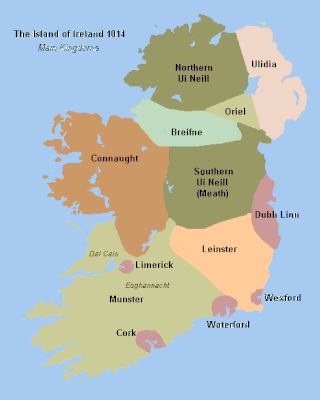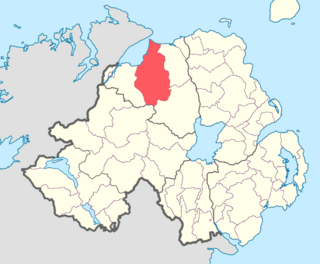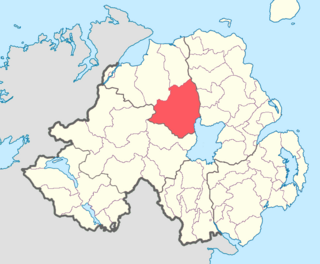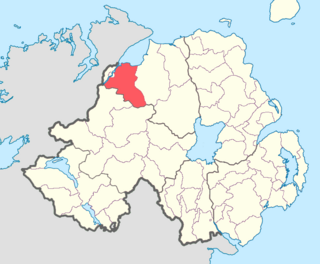
The O'Cahan were a powerful sept of the Northern Uí Néill’s Cenél nEógain in medieval Ireland. The name is presently anglicized as Keane, O'Kane and Kane.

Dál nAraidi or Dál Araide, sometimes Latinised as Dalaradia or Anglicised as Dalaray, was a Cruthin kingdom, or possibly a confederation of Cruthin tribes, in north-eastern Ireland during the Middle Ages. It was part of the over-kingdom of Ulaid, and its kings often contended with the Dál Fiatach for the over-kingship of the province. At its greatest extent, the borders of Dál nAraidi roughly matched those of County Antrim, and they seemed to occupy the same area as the earlier Robogdii of Ptolemy's Geography, a region shared with Dál Riata. Their capital was Ráth Mór outside Antrim, and their eponymous ancestor is claimed as being Fiachu Araide.

Tír Eoghain, also known as Tyrone, was a kingdom and later earldom of Gaelic Ireland, comprising parts of present-day County Tyrone, County Armagh, County Londonderry and County Donegal (Raphoe). The kingdom represented the core homeland of the Cenél nEógain people of the Northern Uí Néill and although they ruled, there were smaller groups of other Gaels in the area. One part of the realm to the north-east broke away and expanded, becoming Clandeboye, ruled by a scion branch of the O'Neill dynasty. In one form or another, Tyrone existed for over a millennium. Its main capital was Dungannon, though kings were inaugurated at Tullyhogue Fort.

Airgíalla was a medieval Irish over-kingdom and the collective name for the confederation of tribes that formed it. The confederation consisted of nine minor kingdoms, all independent of each other but paying nominal suzerainty to an overking, usually from the most powerful dynasty. Airgíalla at its peak roughly matched the modern dioceses of Armagh and Clogher, spanning parts of counties Armagh, Monaghan, Louth, Fermanagh, Tyrone and Londonderry. Its main towns were Armagh and Clogher. The name's usage survives as a cultural area of folk tradition in South East Ulster and adjoining areas of County Louth.

The Earldom of Ulster was an Anglo-Norman lordship in northern medieval Ireland, established by John de Courcy from the conquest of the province of Ulaid in eastern Ulster. It was the most important Anglo-Norman lordship in the north of Ireland. At its greatest extent it extended as far west as the Inishowen peninsula in modern-day County Donegal, which was at one time the power-base of the Northern Uí Néill.
Dúngal Eilni mac Scandail was a Dál nAraidi king of the Cruthin. He ascended to this position some time after 668. He was the son of Scandal mac Bécce, a previous king.
Máel Dúin mac Máele Fithrich was a King of Ailech and head of the Cenél nEógain branch of the northern Uí Néill. He had married Cacht ingen Cellaig, daughter of the high king Cellach mac Máele Coba of the Cenél Conaill and their son Fergal mac Máele Dúin was high king of Ireland.
The Ciannachta were a population group of early historic Ireland. They claimed descent from the legendary figure Tadc mac Céin. Modern research indicates Saint Cianán and his followers may have been the origin behind the tribal name as it is a late construction similar in form to Eóganachta and Connachta. They first appear in historical sources in the 6th century, and were found in several parts of the island, including in Brega and Airgialla. The Ciannachta groups were absorbed over time.

Keenaght is a barony in the mid-northerly third of County Londonderry, Northern Ireland. It connects to the north-Londonderry coastline, and is bordered by four other baronies: Coleraine to the east; Loughinsholin to the south-east; Tirkeeran to the west; and Strabane Upper to the south-west. It was the territory of the Cianachta Glengiven from the 5th century until its takeover in the 12th century by the Ó Cathaín's. The largest settlement in the barony is the town of Limavady.

Loughinsholin is a barony in County Londonderry, Northern Ireland. Its southeast borders the northwest shore of Lough Neagh, and itself is bordered by seven other baronies: Dungannon Upper to the south; Strabane Upper to the west; Keenaght and Coleraine to the north; Kilconway, Toome Upper, and Toome Lower to the east. It was formed largely on the extent of the northern part of the medieval Irish túath of Uí Tuirtri.

Tirkeeran is a barony in County Londonderry, Northern Ireland. It connects to the north-Londonderry coastline, and is bordered by four other baronies: Keenaght to the east; Strabane Lower to the south-east; North West Liberties of Londonderry to the west; Strabane Upper to the south.

Cairbre Drom Cliabh, was an Irish túath in the ancient confederation of Íochtar Connacht, now County Sligo in the west of Ireland. It is now represented by the barony of Carbury. Also known as Cairbre na Catha. It existed from at least the 6th century to the 16th century AD.

The Northern Uí Néill is any of several dynasties in north-western medieval Ireland that claimed descent from a common ancestor, Niall of the Nine Hostages. Other dynasties in central and eastern Ireland who also claimed descent from Niall were termed the Southern Uí Néill. The dynasties of the Northern Uí Néill were the Cenél Conaill and Cenél nEógain, named after the two most powerful sons of Niall: Conall and Eógain.
The Cenél nEógain or Kinel-Owen are a branch of the Northern Uí Néill, who claim descent from Eógan mac Néill, son of Niall of the Nine Hostages. Originally their power-base was in Inishowen, with their capital at Ailech, in modern-day County Donegal in what is now the west of Ulster. Under pressure from the Cenél Conaill, they gradually spread their influence eastwards into modern counties Tyrone and Londonderry, pushing aside the Cruithin east of the River Bann, and encroaching on the Airgiallan tribes west of Lough Neagh. By the 11th century their power-base had moved from Ailech to Tullyhogue outside Cookstown, County Tyrone. By the 12th century the Cenél Conaill conquered Inishowen; however, it mattered little to the Cenél nEóghain as they had established a powerful over-kingdom in the east that had become known as Tír Eoghain, or the "Land of Owen", preserved in the modern-day name of County Tyrone.
Ó hÁdhmaill is a Gaelic Irish clan from Ulster. The name is now rendered in many forms, most commonly Hamill. The clan are a branch of Cenél nEógain, belonging to the Uí Néill; they claim descent from Eochu Binneach, the son of Eógan mac Néill. Their descendants in Ireland are found predominantly across Ulster, and County Louth, Leinster.
Cumee na Gall O'Cahan was a chief of the O'Cahan of Keenaght, Fir-na-Creeve and Fir Lee in modern-day County Londonderry, Northern Ireland. The family first appears on record in 1138. Cumee was a son of Manus O'Cahan, a man who fell in battle alongside fourteen other members of the O'Cahan in support of Brian O'Neill, king of Tír Eoghain, at the battle of Druim Dearg.
Eilne, also spelt as Eilni, alias Mag nEilne, was a medieval Irish Cruthin petty-kingdom in the over-kingdom of Ulaid. It lay between the River Bann and River Bush, and was centered on Magh nEilne, the "plain of Eilne", spanning north-east County Londonderry and north-west County Antrim, in present-day Northern Ireland. Eilne may represent the name of an original population grouping, though even in the Old Irish period who they were was forgotten.
Dál nAraidi in Tuaiscirt, also known as Dál nAraidi of the North, was a Dál nAraidi petty-kingdom and dynasty located in the over-kingdom of Ulaid, in medieval Ireland. It derived from a branch of the ruling Uí Chóelbad dynasty of Dál nAraidi Magh Line that had conquered the petty kingdom of Eilne at some point in the 7th century. The last known king of Dál nAraidi in Tuaiscirt is recorded in 883, with the territory having been taken over by the 10th century by the Uí Tuirtrí.











